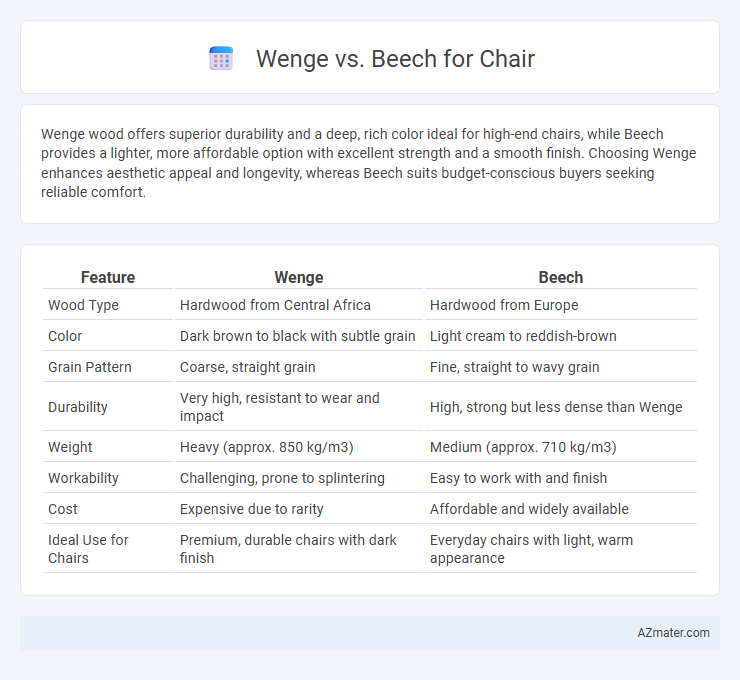Wenge wood offers superior durability and a deep, rich color ideal for high-end chairs, while Beech provides a lighter, more affordable option with excellent strength and a smooth finish. Choosing Wenge enhances aesthetic appeal and longevity, whereas Beech suits budget-conscious buyers seeking reliable comfort.
Table of Comparison
| Feature | Wenge | Beech |
|---|---|---|
| Wood Type | Hardwood from Central Africa | Hardwood from Europe |
| Color | Dark brown to black with subtle grain | Light cream to reddish-brown |
| Grain Pattern | Coarse, straight grain | Fine, straight to wavy grain |
| Durability | Very high, resistant to wear and impact | High, strong but less dense than Wenge |
| Weight | Heavy (approx. 850 kg/m3) | Medium (approx. 710 kg/m3) |
| Workability | Challenging, prone to splintering | Easy to work with and finish |
| Cost | Expensive due to rarity | Affordable and widely available |
| Ideal Use for Chairs | Premium, durable chairs with dark finish | Everyday chairs with light, warm appearance |
Introduction to Wenge and Beech Wood
Wenge wood, native to Central Africa, is renowned for its dark brown to black color with subtle grain patterns, offering a striking, luxurious appearance for chair design. Beech wood, commonly sourced from European and North American forests, features a pale cream color with fine, straight grain, providing a smooth and uniform texture ideal for versatile and durable chairs. Both woods boast high density and excellent workability, but Wenge's unique aesthetics and natural hardness often make it a premium choice compared to the more readily available and cost-effective Beech.
Origin and Availability of Wenge and Beech
Wenge originates from Central Africa, primarily found in countries like the Democratic Republic of Congo and Cameroon, making it a rarer and more exotic hardwood compared to Beech, which is native to Europe and parts of North America, such as the United States and Canada. Wenge's limited growth regions contribute to its higher cost and lower availability, while Beech's widespread distribution ensures it is more readily available and affordable for chair manufacturing. Both woods offer distinct aesthetic qualities, but sourcing Wenge often involves ethical considerations due to its extraction from tropical rainforests.
Physical Appearance: Color and Grain Patterns
Wenge wood displays a rich, dark brown to black color with subtle purplish hues, featuring a striking, straight, and occasionally interlocked grain pattern that gives chairs an elegant, dramatic look. Beech wood offers a lighter, creamy beige to pinkish tone with a fine, consistent, and straight grain, providing chairs a smooth and uniform appearance. The distinct contrast between Wenge's deep, bold coloration and Beech's light, warm tone makes each wood type uniquely suited for different aesthetic preferences in chair design.
Durability and Strength Comparison
Wenge wood is significantly denser and harder than Beech, providing superior durability and resistance to wear in chair construction. Beech, while still strong and resilient, is more prone to dents and scratches under heavy use due to its softer grain. Chairs made from Wenge typically offer better longevity and structural integrity, making them ideal for high-traffic or heavy-duty environments.
Workability: Ease of Crafting Chairs
Wenge is dense and hard, requiring sharp tools and extra effort to craft chairs, but this results in durable, solid furniture. Beech wood is softer and more pliable, making it easier to shape and assemble, ideal for intricate chair designs and faster production. Both woods produce high-quality chairs, but Beech offers superior workability for complex joinery and detailed carving.
Comfort and Aesthetic Appeal
Wenge wood offers a rich, dark finish that enhances modern chair aesthetics with its natural grain patterns, creating a sophisticated and elegant look. Beech wood provides a lighter tone with a smooth texture, contributing to a warm, inviting ambiance and excellent durability for comfortable seating. In terms of comfort, beech's slight flexibility and smooth surface allow for ergonomic designs, while wenge is denser and sturdier, often supporting more structured, firm seating solutions.
Maintenance and Longevity
Wenge wood offers exceptional durability and resistance to wear, making it ideal for long-lasting chair construction with minimal maintenance beyond regular dusting and occasional polishing. Beech wood, while also sturdy, requires more frequent care such as oiling or waxing to maintain its appearance and prevent drying or cracking over time. Chairs made from wenge typically have a longer lifespan due to the wood's natural hardness and moisture resistance compared to beech.
Environmental Impact and Sustainability
Wenge wood, sourced primarily from Central Africa, is known for its slow growth and limited availability, leading to higher environmental concerns due to deforestation and habitat disruption. Beech wood, commonly grown in Europe and North America, is fast-growing and often harvested from sustainably managed forests, resulting in a lower carbon footprint and better renewability. Choosing Beech for chairs supports eco-friendly practices by promoting sustainable forestry and reducing environmental degradation compared to the more environmentally taxing Wenge wood.
Cost Considerations for Wenge vs Beech
Wenge wood is significantly more expensive than beech due to its rarity and exotic origin, increasing costs for high-end chair production. Beech offers a more budget-friendly alternative with good durability and workability, making it popular for mass-market chairs. Choosing between the two depends on balancing cost constraints with desired aesthetics and durability in chair design.
Final Verdict: Choosing the Best Wood for Chairs
Wenge offers durability and a rich dark color, making it ideal for chairs with a modern or luxurious aesthetic, while Beech provides a lighter, softer grain that enhances comfort and workability in traditional designs. Beech's affordability and ease of finishing suit mass production and casual styles, whereas Wenge's hardness and resistance to wear ensure long-lasting chairs in high-traffic environments. For the best wood choice, select Wenge for premium durability and striking appearance, or Beech for versatile, cost-effective comfort and crafting flexibility.

Infographic: Wenge vs Beech for Chair
 azmater.com
azmater.com